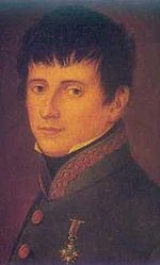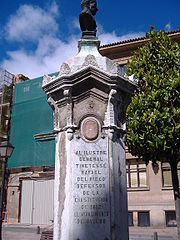
Rafael del Riego
Encyclopedia

Spain
Spain , officially the Kingdom of Spain languages]] under the European Charter for Regional or Minority Languages. In each of these, Spain's official name is as follows:;;;;;;), is a country and member state of the European Union located in southwestern Europe on the Iberian Peninsula...
general and liberal politician, who played a key role in the outbreak of the Liberal Triennium (Trienio liberal in Spanish).
Early life and action in the Peninsular War
Riego was born on 9 April 1784 (according to other sources 24 November 1785) in TineoTineo
- Politics :-Parroquias :-Tourism:The Sacred Art Museum of Tineo is located at the Plaza Alonso Martinez inside the Convento de San Francisco del Monte , a 14th century Roman Catholic church accessible via the AS-217 road.-External links:***...
in Asturias
Asturias
The Principality of Asturias is an autonomous community of the Kingdom of Spain, coextensive with the former Kingdom of Asturias in the Middle Ages...
. After graduating from the University of Oviedo
University of Oviedo
The University of Oviedo is a public university in Asturias . It's the only university in the region. It has three campus and research centres, located in Oviedo, Gijón and Mieres.-History:...
in 1807, he moved to Madrid
Madrid
Madrid is the capital and largest city of Spain. The population of the city is roughly 3.3 million and the entire population of the Madrid metropolitan area is calculated to be 6.271 million. It is the third largest city in the European Union, after London and Berlin, and its metropolitan...
, where he joined the army. In 1808, during the Spanish War of Independence
Peninsular War
The Peninsular War was a war between France and the allied powers of Spain, the United Kingdom, and Portugal for control of the Iberian Peninsula during the Napoleonic Wars. The war began when French and Spanish armies crossed Spain and invaded Portugal in 1807. Then, in 1808, France turned on its...
he was taken captive by the French
France
The French Republic , The French Republic , The French Republic , (commonly known as France , is a unitary semi-presidential republic in Western Europe with several overseas territories and islands located on other continents and in the Indian, Pacific, and Atlantic oceans. Metropolitan France...
and imprisoned in El Escorial
El Escorial
The Royal Seat of San Lorenzo de El Escorial is a historical residence of the king of Spain, in the town of San Lorenzo de El Escorial, about 45 kilometres northwest of the capital, Madrid, in Spain. It is one of the Spanish royal sites and functions as a monastery, royal palace, museum, and...
, from where he eventually escaped.
On 10 November he took part in the Battle of Espinosa de los Monteros
Battle of Espinosa
The Battle of Espinosa was a battle of the Napoleonic Wars, fought on November 10 and November 11, 1808 at the township of Espinosa de los Monteros in the Cantabrian Mountains...
, after which he once again was taken prisoner. Three days later he was sent to France, and after he changed his name to "Riego" (without the "del"), was eventually released. He traveled around England
England
England is a country that is part of the United Kingdom. It shares land borders with Scotland to the north and Wales to the west; the Irish Sea is to the north west, the Celtic Sea to the south west, with the North Sea to the east and the English Channel to the south separating it from continental...
and the German states
Confederation of the Rhine
The Confederation of the Rhine was a confederation of client states of the First French Empire. It was formed initially from 16 German states by Napoleon after he defeated Austria's Francis II and Russia's Alexander I in the Battle of Austerlitz. The Treaty of Pressburg, in effect, led to the...
, and in 1814 he returned to Spain right before the Spanish Constitution of 1812
Spanish Constitution of 1812
The Spanish Constitution of 1812 was promulgated 19 March 1812 by the Cádiz Cortes, the national legislative assembly of Spain, while in refuge from the Peninsular War...
was abolished by Fernando VII. In Spain Riego once again joined the army with a rank of lieutenant colonel and took an oath to the Constitution. During the six years of absolutism
Absolute monarchy
Absolute monarchy is a monarchical form of government in which the monarch exercises ultimate governing authority as head of state and head of government, his or her power not being limited by a constitution or by the law. An absolute monarch thus wields unrestricted political power over the...
, that followed the restoration of King Fernando VII, Spanish liberals wished to restore the Spanish Constitution, which the King had abolished in May 1814. During this time Riego joined the freemasons and collaborated with liberals in several conspiracies against the King, which failed.
The 1820 revolt and the restoration of the Constitution
In 1819 the King was forming an army of ten battalionBattalion
A battalion is a military unit of around 300–1,200 soldiers usually consisting of between two and seven companies and typically commanded by either a Lieutenant Colonel or a Colonel...
s to fight in the Spanish American wars of independence. Riego was given command of the Asturian
Asturias
The Principality of Asturias is an autonomous community of the Kingdom of Spain, coextensive with the former Kingdom of Asturias in the Middle Ages...
Battalion. After arriving in Cádiz
Cádiz
Cadiz is a city and port in southwestern Spain. It is the capital of the homonymous province, one of eight which make up the autonomous community of Andalusia....
, together with other liberal officers, he started a mutiny on 1 January 1820 demanding the return of the 1812 Constitution. Riego's troops marched through the cities of Andalusia with the hope of starting an anti-absolutist uprising, but the local population was mostly indifferent. An uprising, however, did take in Galicia, and it quickly spread throughout Spain. On 7 March 1820 the royal palace in Madrid was surrounded by soldiers under the command of General Francisco Ballesteros
Francisco Ballesteros
Francisco Ballesteros, emerged as a career Spanish General during the Peninsular War.Ballasteros served against the First French Republic in the 1793 War of the Pyrenees...
, and on 10 March the King agreed to restore the Constitution.
The newly founded progressive government promoted Riego to field marshal
Field Marshal
Field Marshal is a military rank. Traditionally, it is the highest military rank in an army.-Etymology:The origin of the rank of field marshal dates to the early Middle Ages, originally meaning the keeper of the king's horses , from the time of the early Frankish kings.-Usage and hierarchical...
and made him Captain General
Captain General
Captain general is a high military rank and a gubernatorial title.-History:This term Captain General started to appear in the 14th century, with the meaning of commander in chief of an army in the field, probably the first usage of the term General in military settings...
of Galicia. On 8 January 1821 he took command of Aragon
Aragon
Aragon is a modern autonomous community in Spain, coextensive with the medieval Kingdom of Aragon. Located in northeastern Spain, the Aragonese autonomous community comprises three provinces : Huesca, Zaragoza, and Teruel. Its capital is Zaragoza...
, and moved to Zaragoza
Zaragoza
Zaragoza , also called Saragossa in English, is the capital city of the Zaragoza Province and of the autonomous community of Aragon, Spain...
. On 18 June of the same year he married his cousin Maria Teresa del Riego y Bustillos. On 4 September 1821 because of a failed republican
Republicanism
Republicanism is the ideology of governing a nation as a republic, where the head of state is appointed by means other than heredity, often elections. The exact meaning of republicanism varies depending on the cultural and historical context...
revolt, he was wrongly accused of republicanism and imprisoned. However, his popularity grew, and demonstrations took place in Madrid demanding his release. In March 1822 he was elected to the Cortes Generales
Cortes Generales
The Cortes Generales is the legislature of Spain. It is a bicameral parliament, composed of the Congress of Deputies and the Senate . The Cortes has power to enact any law and to amend the constitution...
, and eventually released from prison.

Congress of Verona
The Congress of Verona met at Verona on October 20, 1822 as part of the series of international conferences or congresses that opened with the Congress of Vienna in 1814-15, which had instituted the Concert of Europe at the close of the Napoleonic Wars....
, the Quintuple Alliance
Quintuple Alliance
The Quintuple Alliance came into being at the Congress of Aix-la-Chapelle in 1818, when France joined the Quadruple Alliance created by Russia, Austria, Prussia and the United Kingdom...
countries decided that a Spain bordering on republicanism was a threat to the balance of Europe, and France was chosen to restore by force an absolute monarchy in Spain. On 7 April 1823 the French army crossed the borders. Riego took command of the Third Army, and resisted the invaders as well as local absolutist groups. But on 15 September he was betrayed, and taken prisoner in a country estate near the village of Arquillos, Jaén. He was taken to Madrid. Despite asking for clemency from the King, Riego was found guilty of treason as he was one of the members of parliament who voted in favor of taking the power from the King. On 7 November 1823 Rafael del Riego was hanged at La Cebada Square in Madrid.
Memory
El Himno de Riego, a song written in honour of Riego, became the anthem of the Second Spanish RepublicSecond Spanish Republic
The Second Spanish Republic was the government of Spain between April 14 1931, and its destruction by a military rebellion, led by General Francisco Franco....
(1931–1936). Currently his portrait is displayed in the building of the Cortes Generales
Cortes Generales
The Cortes Generales is the legislature of Spain. It is a bicameral parliament, composed of the Congress of Deputies and the Senate . The Cortes has power to enact any law and to amend the constitution...
.

